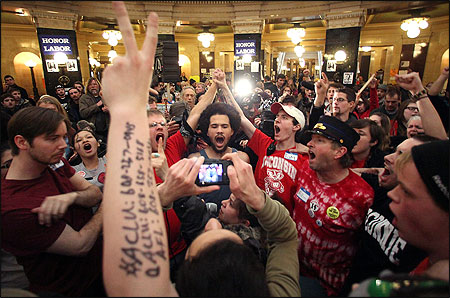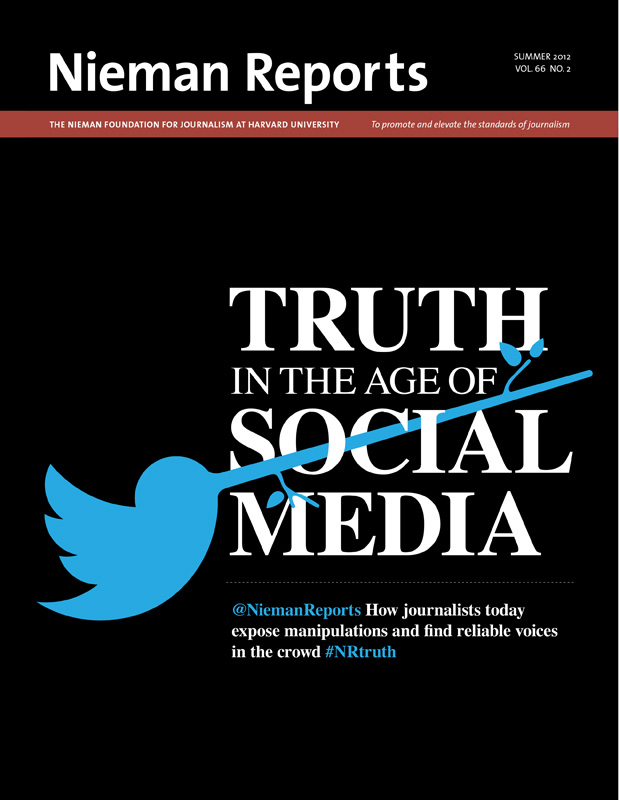
Demonstrators inside the Capitol in Madison, Wisconsin, cheer in February 2011 as the deadline drew near to vacate the premises or face arrest. Photo by Craig Schreiner/Wisconsin State Journal.
After a string of breaking news that stretched over weeks, an uneasy calm had finally settled over Madison, Wisconsin, by early March 2011.
A month earlier Governor Scott Walker had dropped “the bomb,” as he would later call his controversial decision to effectively wipe out collective bargaining for public employees. Tens of thousands of protesters swamped the state Capitol, and the reporters, photographers and editors at the Madison-based Wisconsin State Journal strained to cover every development that ensued: The Senate’s minority Democrats fled to Illinois to deny the Republicans a quorum. Schools closed when thousands of teachers joined the protests. Demonstrators occupied the state’s ornate Capitol building 24 hours a day, turning it into a protest village.
Each day brought a number of developments that taxed the newspaper’s two Statehouse reporters and forced us to abandon beat coverage elsewhere to throw more bodies at the story. With so much news breaking, just posting updates to the paper’s website suddenly felt inadequate. We needed to meet readers where they were experiencing the story: on their cell phones, on Facebook, and especially on Twitter. Several of us already had Twitter and Facebook accounts, but these were mostly ornaments. The events of February and March 2011 forced us to integrate social media into everything we do.
We acted in part out of self-preservation. If the Internet is the equivalent of giving every citizen a printing press, Twitter is like giving every person his or her own talk radio show: loud and highly charged interpretations of the news, broadcast to hundreds or thousands of followers. As Madison burned, the cacophony of voices was deafening. The paper risked being crowded out, the hard work of its independent and well-sourced reporters eclipsed by partisans.
We began by capturing an audience of our own. Equipped with smartphones, our Capitol reporters tweeted updates several times a day, often breaking news on Twitter even before informing their editors. When the protests started, reporter Mary Spicuzza had perhaps 500 followers on Twitter. Today, some 3,600 people hang on her every tweet.
Others needed to be brought up to speed in a hurry. We improvised, providing some reporters with iPod touches and mobile hotspots, and setting them up with Twitter accounts before sending them out the door. By the first weekend of protests, we had nine reporters in the field, all of them tweeting and contributing to a live blog, which drew 24,000 readers over two days. (By comparison, the State Journal’s circulation is around 83,000 daily and 118,000 Sunday.)
As a source of tips, Twitter was indispensable, opening up listening posts across the state and across the political spectrum that could quickly influence coverage plans for the day. Of course, the downside of so much feedback is that it can quickly become overwhelming. I began reacting to the merest development like a jumpy day trader, sending Spicuzza and fellow reporter Clay Barbour down endless rabbit holes to check out every rumor: No, police were not massing in riot gear on the edge of the city. No, the administration was not sealing the windows of the Capitol shut.
Over time, we got better at sifting out the chatter. We also knew we couldn’t risk the newspaper’s credibility by tweeting unverified information. What emerged was a common-sense policy akin to the paper’s ban on writing off the police scanner: Don’t forward tweets from unknown or unreliable sources. Don’t retweet claims that haven’t been independently verified. Stick to the facts.
Of course, those outside the paper weren’t bound by any such constraints. With anger on both sides at a fever pitch, the media could not escape becoming part of the story. There were daily Twitter and Facebook campaigns taking issue with our coverage; knowing, conspiratorial treatises that only someone ignorant of the much more banal inner workings of a newspaper could conjure. Responding to those charges was tempting but often created more trouble than it was worth.
Going Viral
By early March, everyone was exhausted, beat up, and badly nourished. The stalemate in the Senate at least allowed us to catch our breath. “Normalcy is returning,” read one headline on March 8.
At 4 p.m. the next day, the Senate came back in a surprise session. Spicuzza learned that a conference committee had been hastily called for that day to approve the collective bargaining bill and send it back to both houses for a final up-or-down vote. She immediately tweeted that, but none of us knew what it meant. The bill hadn’t passed the Senate due to the Democrats’ boycott. How could it suddenly show up in a conference committee, which typically irons out differences between competing versions of legislation passed by both houses?
While Spicuzza and Barbour chased down legislators and their attorneys, they continued tweeting and phoning in updates to a story developing online. The story went viral. Within an hour, Spicuzza could see people running toward the Capitol, and the rotunda once again beganfilling with singing, chanting protesters. After a brief and emotionally charged meeting, the committee chairman hammered the bill through. Half an hour later, the bill passed the Senate; in the morning it would pass the Assembly. The trick, it turned out, had been to remove fiscal elements from the bill so that the quorum required was smaller and it could be passed without the Democrats.
Another spasm of stories followed, and the events of that winter reverberated over the next year as recall campaigns were launched against the governor and other elected officials.
Not everything we tried worked. Sometimes we tweeted important developments but neglected to reprise those in print, forgetting that the two platforms served largely different audiences. I wish that some days we had held back more reporters to develop meatier enterprise stories (we carved out time for several of these, but not enough).
And we continue to struggle with the balance between immediacy and credibility. Like newsrooms across America, the State Journal has had to make considerable cutbacks in staff in recent years. At the same time, we’ve severely flattened the time reporters have to formulate questions, evaluate the answers, and present information in a comprehensible way. Our challenge is to keep these new tools from hijacking our main purpose, which remains the time-consuming work of cultivating sources, digging through records, analyzing data, and holding public officials accountable.
Phil Brinkman is the city editor of the Wisconsin State Journal, which was a 2012 Pulitzer finalist for its breaking news coverage of 27 days of around-the-clock protests at the state Capitol in Madison.


